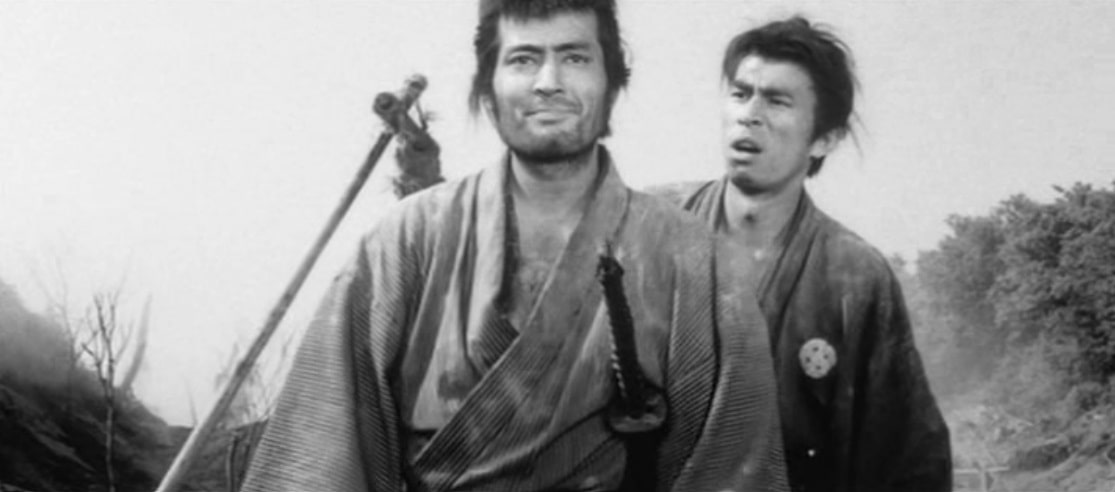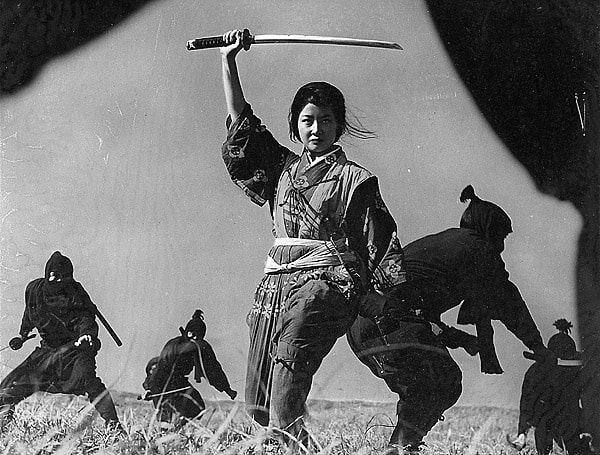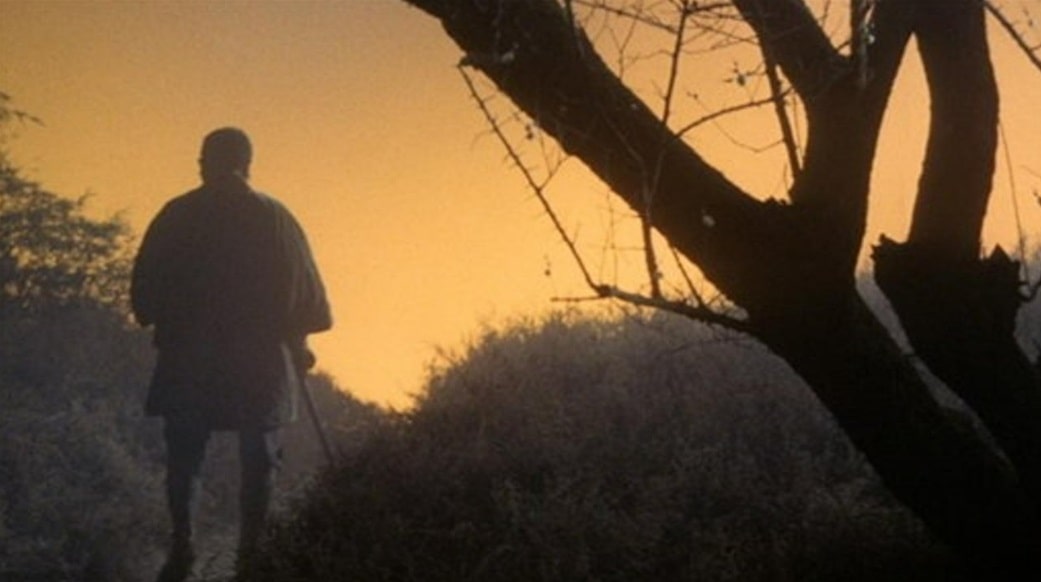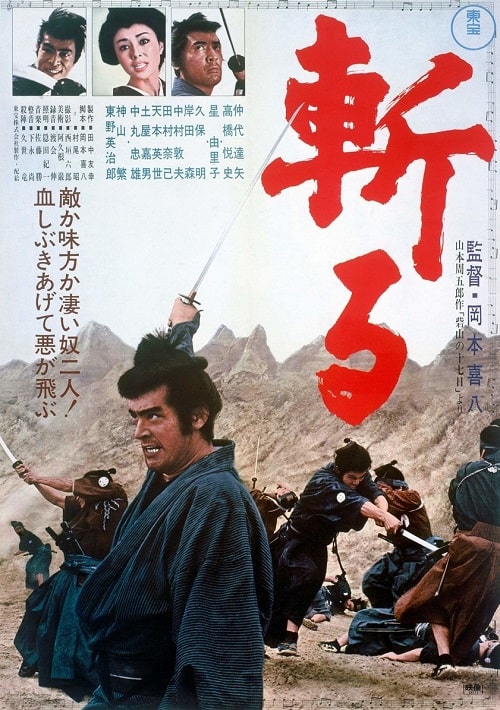Ellsworth’s Cinema of Swords: Laugh, Samurai, Laugh
Warring Clans (Japan, 1963)
In the Fifties and Sixties, samurai adventures occupied roughly the same entertainment niche in Japan as Westerns in the USA. Just as there were comedy Westerns, there were funny chambara films — though based on the movies that actually made it to Europe and the States, you might not know it, as the samurai films that got overseas distribution were mostly as serious as a hanging. However, tragedy tomorrow, comedy tonight: this week we’re taking a look at three of the best humorous chambara films. They tend more toward sly parody than slapstick, so don’t expect Mel Brooks. But count on it: they still feature plenty of swordplay.
Warring Clans
Rating: ****
Origin: Japan, 1963
Director: Kihachi Okamoto
Source: Samurai DVD
It’s the early 1570s, during the historic clash between the Oda and the Takeda — the warring clans of the title. On a lonely mountainside, a samurai, Ochi (Yuzo Kayama), is escaping from the Takeda when he’s confronted by Suzumeno, the Takeda’s boss ninja. The ninja is a cunning fighter, but Ochi slashes him across the face and throws him over a cliff. He’s then congratulated for his feat by two other samurai who rise out of the underbrush: rugged Harima (Ichirô Nakatani), who salutes him ironically, and ragged Kinoshita (Makoto Sato), whose praises are rather more sarcastic, and who suggests that, since he’s left the Takeda, Ochi should find a new patron: himself. Ha ha, just joking! But look, here comes a caravan of the Bashaku, an armed mercenary shipping company — maybe you could join them to escape your pursuers?
The three samurai, Ochi, Harima, and Kinoshita, united in mutual distrust and humorous skepticism, are the center around which this story of samurai intrigue and romance turns. Writer-director Kihachi Okamoto (Samurai Assassin, Sword of Doom), a master of the elements of chambara adventure, combines them here with a light touch, and sly irony is the order of the day.
Taking Kinoshita’s advice, Ochi and Harima pretend to be doofuses fighting over a stolen rice ball, and cajole the caravan’s leader, Lady Saghiri (Yuriko Hoshi), into letting them join the Bashaku. She takes them back to their forest compound, but that evening Kinoshita shows up in his true guise as an envoy of the Oda. He wants the Bashaku to smuggle 300 muskets stolen from the Takeda across the mountains, and he’s willing to pay well for the job. The Bashaku run an honest caravan, but persuaded by the wily Kinoshita’s gold, they agree.
As Ochi soon finds out, Kinoshita is hedging his bets, as he also hires a gang of pirates led by “Princess” Takihime (Kumi Mizuno) to carry another load of 300 muskets to Oda. What is going on? Between the manipulations of the glib Kinoshita and the threats of the sinister Suzumeno (who survived his cliff dive, of course), can either the Oda or the Takeda be trusted? Ochi tells Harima that in these times, the only thing a samurai can really trust is his heart — and yet, what if Ochi loses his heart to the feisty Saghiri?
Serious questions, but Okamoto keeps the tone light and the action moving. Ochi is a fine young romantic hero, Harima is an engaging mentor-cum-sidekick, Kinoshita is a silver-tongued rascal, Saghiri is fiercely adorable, and the Bashaku are a bunch of loveable goofballs. There are traitors and sudden reversals, samurai archery tricks, a bandit with esoteric hypno-powers, jars of drugged sake — and best of all, by popular demand, a shipboard brawl of pirates vs. ninja! Good times. And do you suppose those muskets are going to find a use in the slam-bang finale? Well, you know what Chekhov says about that gun you saw in the first act. 300 muskets? You do the math.
Samaritan Zatoichi
Rating: *****
Origin: Japan, 1968
Director: Kenji Misumi
Source: Criterion DVD
This is superb. Like all the best entries in the series, Samaritan is touching, ironic, suspenseful, exciting, and occasionally disturbing, but also, thanks to the capers of star Shintaro Katsu and his comical friend Takuya Fujioka, this film is also very funny, an aspect of the Zatoichi movies that hadn’t been front and center for a while. The jokes are broad, but ace director Kenji Misumi keeps things taut and never overplays a gag.
Samaritan also packs a lot of story into its 84 minutes, but you’re never in doubt as to what’s going on. Zatoichi (Katsu), traveling as always, enters a new town and accepts the hospitality of its yakuza boss, Kumakichi, and in return is asked to accompany some of the boss’s goons on a mission to collect a debt. The debtor, drunk and obstreperous, decides to fight the goons and Ichi kills him, just as his sister Osode (Yoshiko Mita) arrives with the money to pay off the debt. The goons take the money and try to take the sister into the bargain, but Ichi, guilt-ridden, drives them off, making an enemy of Boss Kumakichi.
Osode sets off to return to her hometown of Suwa, and Ichi appoints himself her unwanted protector and follows along. Also following is Kashiwazaki (Makoto Sato), a roguish ronin out for whatever he can get, including the gorgeous Osode, who is also desired by the local magistrate and by the brothel-boss of Suwa. Kumakichi’s thugs are in pursuit as well, hoping to abduct Osode for the magistrate, while ahead wait the yakuza of Suwa, who owe Kumakichi a favor. This is a lot of moving parts, and when they collide, conflicts erupt; there’s a good deal of swordplay in this picture, but the fights are all beautifully shot in a stunning variety of settings. There’s also a wild chase scene involving Kashiwazaki the ronin, Osode carried in a speedy palanquin, five yakuza goons, and a desperate Zatoichi on a commandeered horse blindly galloping out of control. Whoa!
The acting is as good as the action. Katsu is at the top of his game, and Mita, one of Japanese cinema’s leading female actors, is poignant as Osode, dealing with her guilt, self-loathing, and gradual, grudging admiration for Ichi. Sato also gives a fine, subtle performance as the sardonic ronin Kashiwazaki, and his encounters with Ichi are among the best in the series. Their final duel is fought against a background of thundering drums welcoming in the new year — and deafening Zatoichi, who can’t hear the samurai coming.
In the end, as always, Ichi moves on, telling Osode he only wants her happiness, though she cries, “How can I ever be happy after you’ve gone away?” As Ichi shuffles off into the first sunrise of a new year, in a way Katsu himself is disappearing over the horizon, as he will take the next year off from the Zatoichi franchise to act in Hitokiri and other films. Samaritan is the last of a remarkable eight-year run of films, every one of which is worth watching. There will still be a lot more Zatoichi to follow, but the features are mostly special one-offs of one sort or another, interesting but inconsistent. However, with this film Shintaro Katsu ended his first Zatoichi run on a very high note indeed.
Kill!
Rating: ****
Origin: Japan, 1968
Director: Kihachi Okamoto
Source: Criterion DVD
This picture, co-written and directed by Kihachi Okamoto (Warring Clans, Samurai Assassin), is a hilarious mashup of clichés and tropes from samurai films of the Fifties and Sixties, including the finest chambara movies of Akira Kurosawa. And yet, it’s also a solid story well told with a point to make, as often touching and exciting as it is funny. It also doesn’t hurt that it has the great Tetsuya Nakadai in the lead role. Let’s go!
It’s 1833, and the wheels are coming off the Shogunate. In a town twice as ruined as the one in Yojimbo, in a dust storm twice as dusty and fierce, not one but two strangers drift in to the wreckage, both looking for any work that will get them a decent meal. The first one, Tabata (Etsushi Takahashi), is a farmer pretending to be a samurai, a good-hearted but rather dim man who’s sold his farm for a sword but never really used it. The second, Genta (Nakadai), is a down-on-his-luck samurai who’s pretending to be a yakuza because the crime families always look after their own, right? Only not in this town. In this town, even the old woman who ran the last noodle shop has hanged herself, because, as the last yakuza tells Genta, the samurai ruin everything.
And they’re not done with their ruining, because not even this wreck of a town can avoid clan politics. Seven young samurai appear, determined to reform their clan by ambushing and slaying a corrupt chancellor, though Genta warns them not to be rash. Too late! After a terrific mêlée, the corrupt chancellor and his guards are slain. And then, as the seven young zealots congratulate themselves, the betraying begins — because the idealistic young swordsmen have been used as catspaws by Chamberlain Ayuzawa (Shigeru Koyama), who is eliminating all his rivals for complete clan control, and now must make sure everyone who can betray him to the government in Edo is likewise removed. (Sound like Sanjuro? It was adapted from the same novel on which Kurosawa’s film was based.)
Tabata and Genta get caught up in this deadly intrigue, Tabata because he’s eager to prove himself a warrior and gain samurai status, and Genta because what’s happening to this clan is all too similar to what happened to his own, the tragedy that made him want to give up the samurai life. Though they almost immediately end up on opposite sides, the would-be samurai Tabata and the ex-samurai Genta keep saving each other, as Genta adopts one ridiculous guise after another to try to rescue the young idealists and bring down Ayuzawa. Nakadai is slyly hilarious as Genta (is there any role he couldn’t play?), and Koyama as Ayuzawa is icily villainous while maintaining absolute respectability.
The jokes are funny, the swordplay is top-notch, the skewering of samurai culture is on point, and this is also one of the best-looking chambara films of the late Sixties. If you get a chance to see it, don’t miss it.
Where can I watch these movies? I’m glad you asked! Many movies and TV shows are available on disk in DVD or Blu-ray formats, but nowadays we live in a new world of streaming services, more every month it seems. However, it can be hard to find what content will stream in your location, since the market is evolving and global services are a patchwork quilt of rights and availability. I recommend JustWatch.com, a search engine that scans streaming services to find the title of your choice. Give it a try. And if you have a better alternative, let us know.
Previous installments in the Cinema of Swords include:
Warmongers
Fables and Fairy Tales
Goofballs in Harem Pants, Part 2
Timey-Wimey Swordy-Boardy
Boy-Toys of Troy
Piracy – Two Wrecks and a Prize Ship
Postwar in the Greenwood
The Barbarian Boom, Part 4
Blood-Red and Blind: The Crimson Bat
Updating the Classics
Sink Me! Scarlet Pimpernels!
The Barbarian Boom, Part 5
Alexandre/Alexander
Musashi and Kojiro
Forgotten Fantasies
More o’ Zorro
LAWRENCE ELLSWORTH is deep in his current mega-project, editing and translating new, contemporary English editions of all the works in Alexandre Dumas’s Musketeers Cycle; the fifth volume, Between Two Kings, is available now from Pegasus Books in the US and UK, while the sixth, Court of Daggers, is being published in weekly instalments at musketeerscycle.substack.com. His website is Swashbucklingadventure.net. Check them out!
Ellsworth’s secret identity is game designer LAWRENCE SCHICK, who’s been designing role-playing games since the 1970s. He now lives in Dublin, Ireland, where he’s a Narrative Design Expert for Larian Studios, writing Dungeons & Dragons scenarios for Baldur’s Gate 3.




I haven’t seen the any of these movies even the Zatoichi one, though I’ve seen plenty of movies in that series. Thing is a month or so ago I was too sick to work so I stayed home and watched the Seven Samurai. I noticed something about the movie I’d either not notice or forgotten. That the movie is really quite funny. It is still the grand epic that everyone thinks it is but there was plenty of genuine humor in it.
Samaritan Zatoichi does indeed have amusing moments, but it also has my favorite climactic duel of the series. Our hero really seems up against it for much of the battle, but when he finally takes out his foe it’s with a spinning triple strike of blinding speed. Superb swordplay.
Also, and this is of lesser note, the villain, after taking a wound from Zatoichi, snatches a folded bit of cloth from his robes and bites down on it. I recall being told that some samurai carried these cloth ‘handkerchiefs’ for the express purpose of having something bite down upon should they be wounded, but I can’t recall ever seeing one in action in any other samurai movie. Anyone seen these elsewhere?
I’ve seen a quite a few of these movies and tv shows, and I’ve never seen or heard of that before. I know that in general, the Samurai and regular Japanese carried paper and cloth around for use as napkins, handkerchiefs, toilet paper, and for the Samurai, sword cleaners to wipe the blood off their blades before re-sheathing them.
Another Ellsworth’s Cinema of Swords? Laughing Samurai? What a concept!
I’ve not seen any of these three films and I thought I saw all of the initial run of the Zatoichi films.
They sound great and now I’ve got to see them. Thanks again, Mr. Ellsworth, for showing me good things I never knew existed.